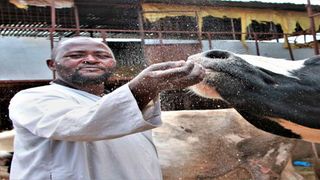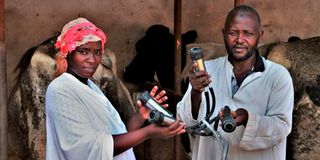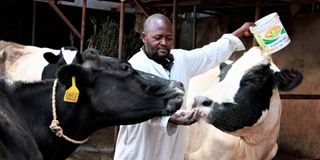
Ismael Mwinyi on his farm in Makindu Township, Makueni County.
| Pius Maundu | Nation Media GroupSeeds of Gold
Premium
How our four cows thrive on tiny farm
What you need to know:
- Ismael Mwinyi keeps dairy cows on 45 by 70 feet land reaping big.
- To maximise on the little space, Mwinyi has installed a storey shed next to the cowshed where he stocks hay.
Several customers normally line up for milk every day at Ismael Mwinyi's homestead in Manyatta Estate in Makindu Township, Makueni County.
The primary school teacher keeps dairy cattle on his 45 feet by 70 feet plot, where he also stays with his family. Mwinyi is not the typical urban farmer who grows or produces food in a city or a heavily populated town.
Makindu is a dusty, rural township on Mombasa-Nairobi highway surrounded by a sunbaked countryside. And as its population grows and land sub-division gathers pace, land sizes are shrinking forcing farmers like Mwinyi to embrace urban farming.
“Mine is urban farming in a rural set up,” he says as he chuckles while ushering Seeds of Gold team on his farm. His farm stands out in an arid region where farmers shy away from dairy farming and stocking hybrid cattle.
From the comfort of his living room in his three-bedroom bungalow, Mwinyi locks eyes with his four Friesian cows, three of them already in-calf, as they happily feed from a trough lining one edge of the 16 feet by 18 feet cowshed.
To maximise on the little space, Mwinyi has installed a storey shed next to the cowshed where he stocks hay. Three calves roam in a room below the fodder shed. A second room below the hay store hosts the chaff cutter, concentrates and milking kits.
“This is my store, I have to use any little available space,” he says.

Ismael Mwinyi and his wife Nadia on their farm in Makindu Township, Makueni County.
Whereas the venture is a side hustle for Mwinyi who teaches, among other subjects, agriculture to Grade 4 pupils at the nearby Mikululo Primary School, and is also chairman of an association of the Muslim community in the town, it is a full-time occupation for his wife, Nadia. They have employed a farmhand who helps the family feed and water the animals as well as clean the cowsheds.
“We clean the sheds twice daily to not only keep diseases at bay but also ensure we produce quality milk. The waste goes into a septic tank where we later sell it as manure,” offers Nadia.
Dr Daniel Ksee, a director in the department of agriculture in Makueni County, notes that thorough cleaning of the cowshed regularly is a sure way of keeping common diseases such as foot and mouth and mastitis at bay.
“It is the onus of the urban farmer, especially those with tiny farms, to ensure that their animals are confined. They should also ensure that their animals do not pollute the environment thus become a nuisance.”
Selling hybrid cows
Although his cowshed looks overwhelmed, Mwinyi says it is underutilised.
"This shed can comfortably accommodate 10 cows, but right now it hosts the four mature cows and three calves. We sold some two years ago to buy a truck which we use to ferry fodder from farmers,” says Mwinyi, who started the venture 13 years ago with Sh50,000 that he used to buy a Friesian heifer.
Before he started the venture, Mwinyi was selling hybrid cows to local farmers, sourcing them from dairy farmers in Githunguri, Kiambu County.

Ismael Mwinyi feeds cows at his farm in Makindu Township, Makueni County.
"I then decided to venture into dairy farming myself. Since then I have not looked back. The money I get from milk is much better than what I used to get when selling cows. I have chosen to retain both businesses," he said.
The couple has acquired a milking machine to make work easier and guarantee hygiene.
“We milk the animals thrice a day and sell to households and local eateries. We produce and sell at Sh60 each between 70 and 80 litres of milk daily from the four cows. The customers come for the milk themselves,” says Nadia, noting that the income from the sale of milk has enabled them to educate their children while leading a comfortable lifestyle.
According to her, demand for milk in the town and the neighbourhood is huge.
Fodder farming
“We only meet a small fraction of the demand. We regret when some of the customers lack their regular supplies." Mwinyi, who is working on expanding his business, buys green maize stalks from a local farm which grows baby corn, shreds them using a chaff cutter before mixing with assorted fodder grass that include boma rhodes, brachiaria and lucerne sourced from farms in the area.
"One does not need to own grazing land to keep cows. As many farmers around towns embrace fodder farming, dairy farmers in urban settings have at their disposal more and better feeds than they need,” says Dr Moses Mwangi, a South Eastern Kenya University lecturer.
“In addition to buying fodder from other farmers, urban farmers could also grow their own in the limited spaces through hydroponic technology. Importantly, urban farmers should install integrated systems which entail harvesting rainwater from the roofs, turning the animal wastes to generate biogas, and feed for chicken, using the chicken waste to feed cows and the manure from the biogas system to nourish the fodder growing through the hydroponics system,” he adds.





